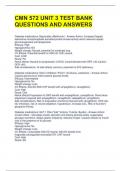CMN 572 UNIT 3 TEST BANK
QUESTIONS AND ANSWERS
Diabetes medications: Biguanides (Metformin) - Answer-Action: Increased hepatic
adenosine monophosphate-activated protein kinase activity which reduces hepatic
gluconeogenesis and lipogenesis.
Efficacy: High
Hypoglycemia: NO
Weight change: Neutral, potential for moderate loss.
CV Effects: Potential benefit for ASCVD, CHF neutral.
Cost: LOW
Route: PO
Renal effects: Neutral for progression of DKD, contraindicated with GFR <30 (caution
GFR <45)
Add considerations: GI side effects common, potential for B12 deficiency.
Diabetes medications: SGLT-Inhibitors "Flozin" (Invokana, Jardiance) - Answer-Action:
Causes glycosuria to lower plasma glucose levels.
Efficacy: Intermediate
Hypoglycemia: No
Weight change: Loss
CV Effects: ASCVD AND CHF benefit with empagilflozin, canagliflozin.
Cost: High
Route: Oral
Renal effects:Progression fo DKD benefit with empagilflozin, canagliflozin. Renal dose
adjustment required with empagilflozin, canagliflozin, dapagliflozin, artugilflozin.
Add considerations: Risk of amputation and bone fractures with canagliflozin. DKA risk,
GU infections, risk of volume depletion, hypotension. Increase LDL, Risk of fournier's
gangrene (Penis).
Diabetes medications: GLP-1 RAs ("tide" Victoza, Trulicity, Byetta) - Answer-Action:
Incretin effect - stimulates insulin secretion and lowers glucose levels, suppresses
glucagon secretion, delays gastric emptying, reduces hunger. Causes release of insulin
only in the presence of fo glucose.
Efficacy: High
Hypoglycemia: No
Weight change: Loss
CV Effects: Lixisenatide ASCVD neutral. ASCVD benefit from
liraglutide>semaglutide>exenatide ER. CHF neutral
Cost: High
Route: SQ
,Renal effects: Progression of DKD benefit from liraglutide. Renal dose adjustment
required from exenatide and lixisenatide. Caution when initiating or increasing dose due
to risk of AKI.
Add considerations: Risk of thyroid C cell tumors in those with family history. GI side
effects common especially if patient eats fast, injection site reactions, risk of acute
pancreatitis.
Diabetes medications: DPP 4 Inhibitors "Gliptin" (Janeuvia) - Answer-Action: Inhibits the
enzyme DPP-4 and prolong the action of endogenously released GLP-1 and GIP to
stimulate insulin secretion and inhibit glucagon secretion.
Efficacy: Intermediate (decrease A1C approx 1 point)
Hypoglycemia: No
Weight change: Neutral
CV Effects: ASCVD neutral, Potential CHF risk with saxagliptin, alogliptin.
Cost: High
Route: Oral
Renal effects: Neutral progression of DKD, Renal dose adjustement for sitagliton,
saxagliptin, alogliptin - an be used in renal impairment. No dose adjustement needed for
linagliptin.
Add considerations: Potential risk for acute pancreatitis, joint pain.
Diabetes medications: Thiazolidinediones "TZD's" (Actos (Pioglitazone), Avandia
(Rosiglitazone))- end in ZONE - Answer-Action: Sensitize peripheral tissues to insulin
Efficacy: High
Hypoglycemia: NO
Weight change: Gain, adipose tissue and fluid retention
CV Effects: ASCVD, potential benefit with pioglitazone. CHF - increased risk.
Cost: LOW
Route: PO
Renal effects: Neutral for progression of DKD, no dose reduction neede, generally not
recommended in renal impairment due to potential for fluid retention.
Add considerations:
Diabetes medications: Sulfonylureas "Ide" (2nd gen -Glipizide, gliburide, glimepiride) -
Answer-Action: Stimulate insulin release from the pancreatic B cells. Not used with type
1.
Efficacy: High
Hypoglycemia: Yes
Weight change: Gain (add adipose tissue)
CV Effects: Neutral
Cost: Low
Route: PO
Renal effects: Neutral for progression of DKD, Dosing considerations - Glyburide not
recommended, conservative use of glipizide and glimepiride.
Add considerations: FDA warning for risk of CV mortality with 1st gen sulfonylureas
(Tolbutamide)
, Diabetes medications: Insulin - Answer-Action: Replace insulin
Efficacy: Highest
Hypoglycemia: Yes
Weight change: Gain
CV Effects: Neutral
Cost: Human insulin- low Analogs- High
Route: SQ
Renal effects: Progression of DKD neutral. Lower insulin doses required with a
decrease in GFR, titrate per clinical response.
Add considerations: Injections site reactions. higher risk of hypoglycemia with human
insulin vs analogs.
Clinical inertia - Answer-Reassess and modify treatment regularly, every 3-6 months
Type 2 diabetes beta cells - Answer-At time of diagnosis, 1/2 of beta cells are
destroyed.
Types of insulin - Answer--Rapid/ short acting insulin: used to quickly reduce blood
glucose levels, usually before meals. Sometimes called prandial insulin.
-Intermediate acting insulin: used for longer blood glucose control, usually twice daily
-Long acting insulin: used as "basal" insulin for 24 hours glucose control
Short-acting: Regular human insulin - Answer-Humulin and Novolin
Onset: 30-60 minutes
Peak: 2-4 hours
Duration: 4-8 hours
Rapid-acting insulin analogs: - Answer-Insulin lispro/Humalog
Insulin aspart/Novolog
Insulin glulisine/ Apidra
Onset: 10-15 minutes
Peak:1-2 hours
Duration: 3-5 hours
Rapid or Short acting insulin Facts - Answer-Both are used before meals as part of a
basal-bolus insulin regime or in insulin pumps
Rapid-acting has a quicker peak and can be taken just a few minutes before a meal.
Due to the quick action of rapid-acting, patients need to eat carbohydrates early in the
meal to prevent hypoglycemia.
Rapid-acting is best for young children with T1DM who may have unpredictable food
intake. It can be given immediately after they have eaten, avoiding over or under
dosage.
Intermediate acting insulin - Answer-Neutral Protamine Hagedorn (NPH)
Has properties of both basal and prandial insulin.




